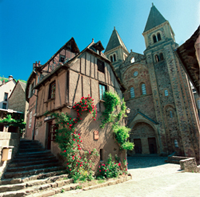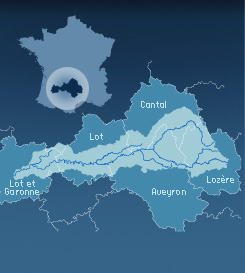 valleedulot.com - The lot Valley - Romanesque Art
valleedulot.com - The lot Valley - Romanesque Art
Observatoiredes crues La vie de
la rivière Virtual visits French version English version

Back to home| What to do in the Lot Valley | Visits | Romanesque Art
Romanesque Art
Take your time as the pilgrims would have done to head to Saint Jacques de Compostelle and this is where you can start to find out about romanesque art. It will guide you from church to church as you contemplate the rich frescoes carved into the stone of the tympanum and the marquees. With as the jewel in the crown, Conques and its fabulous treasure.
Conques (Aveyron)
At the crossing of the gorges de l’Ouche with the valley of the Dourdou, in a natural crater in the shape of a seashell the medieval village comes into view, a Mecca for romanesque art. Its half-timbered corbelled houses huddle around its church.
village comes into view, a Mecca for romanesque art. Its half-timbered corbelled houses huddle around its church.
For centuries the Romanesque abbey church has been a subject of conversation. Begun in 1040, and finished in 1120, it became a “a stopover church” on the road between Le Puy/St Jacques de Compostelle until the 14th century.
Left to decay during the Revolution, it was in 1837 that the commune entrusted an architect from Rodez with its demolition. Prosper Mérimée who was a minister at the time objected, and got it listed as a historic monument and in doing so saved its tympanum sculpted in the 12th century. The restoration work began and was finished in 1950.
In 1994, it was made even more beautiful with the addition of white stained glass which makes it possible to play around with the architecture of the basilica by filtering the light from outside.
Its treasure, jewel in time
Arising from the generosity of the emperors and Carolingian princes, the richness of the treasure became even more so in 866 from the relics of the Sainte Foy then throughout the Middle Ages from the donations from pilgrims. From the 10th century, reliquaries are fashioned at Conques using precious metals, Antique hard stones, pearls and gems. The Majesty of Sainte Foy, a reliquary statue designed to contain the saint's head is the most impressive piece of work. A unique item, one of the greatest examples of medieval silversmith's art in France.
Did you know?
Every year, more than 400,000 visitors stop over in the medieval village in the Aveyron, which is rated as one of the most beautiful villages in France and whose abbey church is a UNESCO world heritage site.
For further information www.conques.fr and at the Conques Centre for European Art and Medieval Civilisation www.ceacm.com
You can find out everything about Romanesque Art in France, region by region, and even in Europe by visiting www.art-roman.net
La Canourgue (Lozere) :
A pilgrimage church, it belonged to the abbey of Saint-Victor de Marseille. Remarkable: its ambulatory, its apsidioles in oven bottom and its chapiters, decorated with acanthus leaves, human and animal figures, one of them depicting a very beautiful
struggle between an archer and a knight.
Saint Alban sur Limagnole (Lozere)
Stopover on the Jacquaire path, the church is the remains of a monastery. You'll notice its mythological chapiters.
Saint Avit (Lot-et-Garonne)
Near Monflanquin, 13th century church with sandstone roofing and perforated metopes.
Saint-Urcize (Cantal)
The church of Saint-Michel was never finished… What was built really is superb: the mixture of granite and of tuff, the comb bell tower, the ambulatory for the pilgrims, chapitals of apsidioles. The village is the starting point for some lovely hiking trips.
Nasbinals (Lozere)
A marker for pilgrims on their way to Saint Jacques de Compostelle, the octogonal bell tower and its church of Sainte Marie is today one of the crowning jewels of Romanesque art in the Aubrac.
Montsalvy (Cantal)
The abbey church calls to mind a monestary from the 11th century. It has been restored and has kept a choir and a Romanesque apse which conceals a treasure of sacred art.
visit montsalvy website
Idea for a stroll (Aveyron) : the very best of Romanesque in the Valley, is to be found in the pays d'Olt. With this pocket-guide, you'll find marvel after marvel : Estables, Saint Geniez d'Olt, Sainte-Eulalie, Bessuéjouls and its bell tower, Espalion and the church of Perse, made entirely of red sandstone... There are a dozen sites over 30kms.
Pays de Serres
No less than eight chapels to explore on your hiking trip through the Lot-et-Garonne. With the remarkable 12th century Sainte-Quitterie church and its wall paintings (scenes from the Passion of Christ of which certains are complete: the Kiss of Judas, the Descent of the Cross, The Entombing...)
Music festival in the Serres which takes place in various Romanesque chapels in August.

 :
: 




